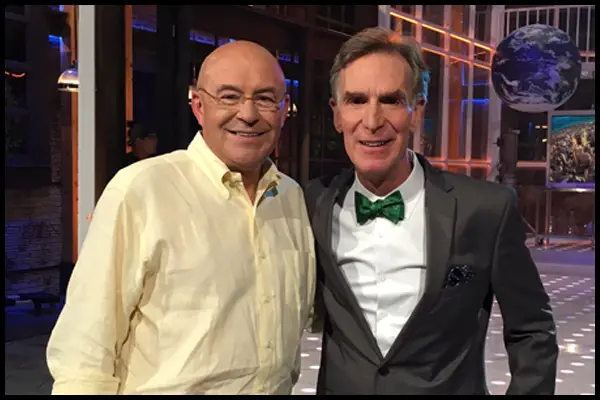
Bill Nye invited then executive vice-president at Monsanto, Robert Fraley, to talk about GMO foods. PHOTO: Monsanto.com
Bill Nye’s TV show on Netflix was designed to make “science” palatable to the masses and to appeal to a wide audience on topics that the mainstream population supposedly does not know a whole lot of information about.
The show titled ‘Bill Nye Saves the World’ was allegedly created to address “anti-scientific claims” but instead used its platform to attack people questioning the safety of vaccine ingredients, laugh at alternative and complementary medicine, and to show an intrinsic and unmistakable bias in favor of GMOs.
Nye appeared to change his tune as he spoke about Monsanto and Bayer’s lab created, pesticide soaked and pesticide producing products in the show, which first came out in 2017.
While Nye once offered up serious skepticism on GMOs,had previously supported GMO labeling, and once said that GMOs need to be studied more thoroughly on a case-to-case basis to be proven safe, announced in July 2015 that he changed his mind, and that he began to support GMOs instead, even though the crops were linked to countless negative health effects in a database of scientific studies recently.
His change of heart happened right after a visit to Monsanto headquarters, leaving many to question what exactly happened at that meeting, and whether he had perhaps even been paid off by the company.
Looking for a healthy, 100% organic spa quality experience at home?
Try these bath soaking salts, creating by a naturopath w/decades of experience!
100% Wildcrafted and Organic (feels absolutely divine after a long day).
Click Here or On the Photo Below (Enter code ALTHEALTHWORKS for a discount at check out)
It is public knowledge that Monsanto/Bayer spends millions of dollars in public relations to push its GMO narrative on the world and media. In fact, Monsanto has a long history of using lobbying and big money donations to influence information and public policy, from voters to politicians to universities and and even public school systems.
Is Bill Nye one of them? Has he been paid off by Monsanto?
While we may never know the answer, the way he spent 26 minutes to present the GMO argument on his TV show (episode 4: “More Food, Less Hype”) is sure to raise additional questions.
Instead of inviting a diverse panel of scientists to debate GMO foods, Bill’s panel of “experts” included a corn and soybean farmer (two main GMO crops), a professor at North Carolina State University (which has a “collaborative relationship” with and is funded by Monsanto), and then executive vice-president at Monsanto, Robert Fraley.
Some members of the audience loudly booed his introduction. Undeterred, Nye continued to stump for Monsanto like a politician on a cross-country speaking tour.

Bill’s panel of “experts” included a farmer a professor, and the executive vice-president at Monsanto, Robert Fraley. PHOTO: Netflix
While the N.C. State professor seemed skeptical of the promises of GMOs and Nye sometimes offered counterpoints, the love-fest for Monsanto’s creations could be felt strongly in the tone of the show, especially in Nye’s final thoughts on the issue.
Monsanto VP Fraley began by offering up the usual pro-GMO talking points: “GMOs are safe, effective, and benefit the environment.” He even threw a “fake news” comment into his statements as well, criticizing alternative media that are pro-organic and do not believe Monsanto’s bold claims.
Monsanto’s three claims above have been debunked many times: GMOs are shown by many independent studies to be neither safe or effective, and definitely not beneficial to the environment.
They also have not lived up to their promises, recent analyses have shown.
A 2016 analysis by the New York Times of available data, published in an article titled ‘Broken Promises of Genetically Modified Crops,’ concluded that GMOs have not done what they are supposed to do. In Europe where the cultivation of such crops is widely banned and they are virtually never grown, increases in yield and decreases in pesticide use were shown to be as good or better than in the U.S. where GMOs are common.
A 2017 report from the United Nations took the modern agricultural industry to task over its “inaccurate and misleading” claims that synthetic pesticide-intensive agriculture (such as “Roundup Ready” GMO crops sprayed en masse with glyphosate) is needed to “feed the world,” a claim that Monsanto/Bayer makes often.
Further Studies Show Evidence of Harm
Studies have shown GMO foods to cause immune problems, gastrointestinal issues, infertility, and negative changes in many organs. Glyphosate, a toxic pesticide used routinely on GMOs, has also been labeled as a probable human carcinogen by the World Health Organization.
As far as effectiveness goes, studies have also shown that it is organic agriculture that can feed the world, while preserving the biodiversity at the same time. Income inequality and food waste are the two biggest obstacles to “feeding the world.”
And when it comes to the environment, instead of using less pesticides, not only do some GMO foods have insecticides inside of them, mass production of GMO crops also led to an estimated 527 million more pounds of herbicides used in the U.S.
To Nye’s credit, he did offer up a few counter-takes to which Fraley seemed a bit uncomfortable answering.
He mentioned Agent Orange, (a chemical defoliant manufactured by Monsanto in the past) the horrific effects of which still cause serious harm to Vietnam War veterans and their children to this day, as well as hundreds of thousands of Vietnamese children who were born with birth effects because of exposure.
Nye also mentioned that Monsanto’s products and farming model have been linked to the decreased Monarch butterfly population,
In summer 2015 he shared his concern much more strongly, however:
“We accidentally have decimated the monarch butterfly population, reduced it over the last two decades by 90 percent,” admitted Nye in summer 2015, implicating the overuse of chemicals from Monsanto and other companies in the decline. “We don’t want that where you are accidentally wiping out a potential pollinator species.”
Despite these and other concerns, Nye’s support for GMOs n the new show was clear as day.
Bill Nye Ignores Science, Backs Monsanto GMOs
Nye started the show by extracting strawberry DNA, before segueing into talking about GMOs.
“GMO are all about that DNA. In a GMO, we take a gene from one organism’s DNA, one species, and put it in another species. It happens in nature by the way,” Nye said.
What Nye fails to mention is that there are no long term, independent studies on the safety of GMOs, and the highly unnatural process of splicing DNA in a laboratory to create novel foods is far from what happens in nature. According to the World Health Organization, GMOs are “organisms in which the genetic material has been altered in a way that does not occur naturally;” in other words they are an entirely new type of organism that represents the biggest change to our food supply in decades (not to mention unlabeled).
Nye also mocked people’s fear of glyphosate, the herbicide that has been linked to cancer.
Fraley meanwhile continued to defend Monsanto, not just GMO foods: “We are a good company,” he laughed.
In the end, Nye continued to show his favoritism, asking his show’s correspondent Derek Muller, “How do we rebrand GMOs?” a similar question to the one posed by longtime Monsanto supporter Hillary Clinton at a 2014 biotech convention in San Diego.
The episode ends with Nye changing the name GMO to OMG to “re-brand” it; ironically, he completely misses the fact that there is a movie called “GMO OMG” from 2013, that explores how Monsanto is destroying our food system, and our health.
“Now, you can see all people, they love it. They love OMGs,” Muller boasts in the show’s ending segment.
Nye closes by voicing his support for GMOs as “another tool in the shed” that can be used in agriculture, flipping the letters of a game show-style sign to change “GMO” to “OMG” as the crowd cheers.
Considering the wave of negative attention that’s been engulfing Monsanto and its GMOs lately, it’s about the best outcome the company could imagined — but one that views more like a PR piece for Monsanto than an actual scientific investigation.
This article was first shared in 2017 and re-shared in March 2024.
Recommended reading:
Monsanto’s Monopoly on Agricultural Research by Big Universities
Exposed: How Monsanto Pays Millions to Lie to Kids Without Parental Consent
A Legacy of Destruction: Monsanto’s Dark History Exposed in Stunning Photo Essay
Thanks for installing the Bottom of every post plugin by Corey Salzano. Contact me if you need custom WordPress plugins or website design.





